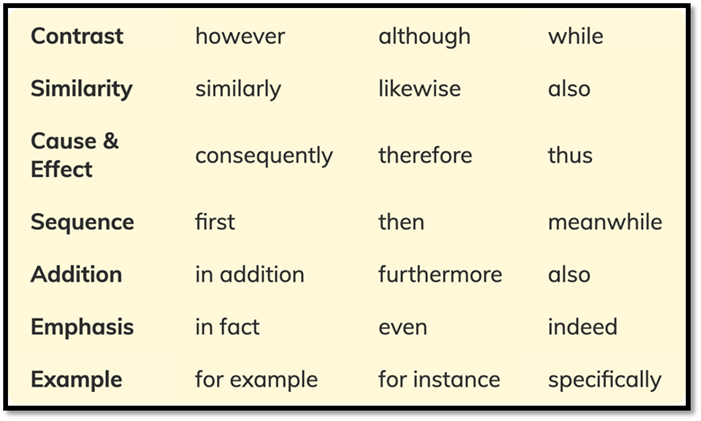Argumentative Essay: Body
Paragraphs
|
Argumentative
Essay: Outline 5 Paragraph
Essay |
|
1. Introduction a. Hook b. Bridge (Background Information) c. Thesis 2.
Body
Paragraph - Reason 1 a.
Topic Sentence - Claim b.
Textual Evidence – Explanation c.
Textual Evidence – Explanation d.
Reasoning 3.
Body
Paragraph - Reason 2 a.
Topic Sentence -Claim b.
Textual Evidence – Explanation c.
Textual Evidence – Explanation d. Reasoning 4. Body
Paragraph - Opposing Arguments Reason a. Topic Sentence (Claim) b. Textual Evidence for opposing
arguments reason – Explanation c. Rebuttal d. Textual Evidence for
Rebuttal – Explanation 5. Conclusion a. Restate Claim (Thesis) b. "So What" Statement |
"Is
social media more beneficial or risky for teenage students?"
Unit 5 Overview
In this unit,
you will learn how to effectively present and support a specific claim or
argument in writing a body paragraph
for an argumentative essay. You will learn the importance of using a clear and
concise topic sentence to introduce
the paragraph's main idea and how to use credible evidence or examples to support the argument. The use of transitional words and phrases is emphasized to help connect
ideas and improve the flow of the writing. You will also learn about comma splices, common punctuation errors,
and how to avoid them using appropriate punctuation or conjunctions when
combining independent clauses. Finally, you will learn the value of
incorporating informational text in your
argumentative essays to support and strengthen your argument. This can include
using statistics, research studies, or expert opinions to provide additional
credibility and validity to your argument.
(Argumentative Essay
final draft will be submitted in Unit 9)
Body Paragraphs
Your body paragraphs have the most important job
in your argumentative essay.
These
paragraphs should convince readers of your thesis
using claims, evidence, and reasoning.
Your body paragraph must
be at least two paragraphs for your argumentative essay.
Argumentative
body paragraphs have three parts.
1. Topic sentence.
We call the
first sentence in a paragraph the topic sentence.
It should start with the argument you plan to make in your paragraph.
A strong
topic sentence is a claim,
meaning that it expresses an opinion. A topic sentence could be stronger if it
simply states a fact or outlines the plan for the paragraph.
Look at the example below.

The first
topic sentence is strong because it claims the author can support it with
facts.
The second
topic sentence needs to be stronger because it just states a fact rather than
sharing an opinion.
Example – Topic Sentence: "Implementing a recycling program in schools
can significantly reduce waste and promote environmental awareness among
students."
Let's Practice
2. Evidence
In each
body paragraph, state a claim showing your true thesis and support it with
specific evidence.
It needs to demonstrate the validity of your argument and provide concrete
examples to support your claims. Strong evidence must be a fact, statistic, or
quotation from a credible source
supporting your topic sentence. Remember to cite your sources.
You are not
limited in how many body paragraphs you use to support your opinion but aim to
include at least two.
Example - Evidence:
"According to a study by the Environmental Protection Agency, schools that
implemented recycling programs reduced their waste by 50% on average."
Let's Practice
3. Reasoning
In your reasoning
sentences, draw a conclusion from your evidence and explain how that conclusion
supports your claim. Explain how the evidence supports and connects the topic
sentence to the thesis statement.
While the
connection between your evidence and claim may be obvious, your readers will be
more convinced if you explain it.
Example - Reasoning: "By
cutting down on waste through recycling, schools can make a tangible impact on
the environment, which benefits the planet and teaches students the importance
of responsible waste management. This hands-on experience empowers students to
become more environmentally conscious, fulfilling the goal of fostering
environmental awareness as stated in the thesis."
Let's Practice
Below is an example of a complete body paragraph below.
|
Thesis: The United States government should lower
the voting age to 16. |
|
Allowing sixteen-year-olds
to vote would make them more likely to vote as adults. A 2003 study
in the American Journal of Political
Science found that citizens who voted in one election were likelier to
vote in the next (Gerber et al.). Therefore, once citizens begin voting, they are likely to
continue voting throughout their lives. Moreover, sixteen-year-olds are more
likely to cast their first vote than eighteen-year-olds. Since lowering its voting age for
local elections, the city of Takoma Park, Maryland, has seen
sixteen-and-seventeen-year-olds voting at higher rates than any other age
group (Rafols-Nunez). Lowering
the voting age would consequently help teenagers develop a lifelong habit of
voting. |
|
topic sentence
evidence reasoning |

You can put
your evidence and reasoning in any order that makes sense as long as your
reasoning shows how the evidence supports your claim.
You must
cite any ideas that you found in other writers' work. Using someone else's
words without a citation is plagiarism,
and your readers won't trust you if you take credit for others' ideas.
When you
introduce your evidence, provide enough source information so your readers know
exactly where the evidence came from.
Transitional Words
Transition
words and phrases link together
different ideas in your text. They help the reader to follow your arguments by
expressing the relationships between different sentences or parts of a
sentence.
Transition
words examples
The proposed solution to the problem needed to be
revised. Therefore, we attempted a
second solution. However, this
solution was also unsuccessful.
Transition
words commonly appear at the start of a new sentence
or clause (followed by a comma), expressing
how this clause relates to the previous one.
There is no reliable data to establish a clear
correlation between these variables. Nevertheless,
it has been argued that a relationship does exist.
Transition
words can also appear in the middle of a clause. It's important to place them
correctly to convey the meaning you intend.
It has nevertheless
been argued that a relationship does exist.
Transitions
show the connection between your ideas. If you choose the right transitions,
readers can understand.
Below are
some examples of transition words and phrases.

Let's Practice
Comma Splices
A comma
splice occurs when two independent clauses are incorrectly joined
with a comma and no conjunction.
To fix a
comma splice, you can:
·
split the comma splice
sentence into two separate sentences, or
·
add appropriate conjunction.
|
Comma Splice Example A |
Correction |
|
My dog didn’t seem
to mind the cold, he ran and ran around the park. |
My dog didn’t seem
to mind the cold. He ran and ran around the park. |
|
Comma Splice Example B |
Correction |
|
I wore my warmest
coat, I wasn’t too cold. |
I wore my warmest
coat, so I wasn’t too cold. |
You can
avoid comma splices by creating compound,
complex, and compound-complex
sentences.
Comma
splice errors are especially easy to make when writing longer sentences that
include multiple independent and dependent clauses.
·
An independent clause is a clause that can stand alone as a sentence.
It has a subject and a verb expressing a complete thought.
·
A dependent clause has a subject and a verb but does not express a
complete thought.
When you
combine independent or dependent clauses in a single sentence, you can avoid a comma splice by using
appropriate conjunctions to write one of these three types of sentences.
|
Compound |
Complex |
Compound-Complex |
|
Combines
two independent clauses with a coordinating conjunction such as and,
but, or so. |
Combines
an independent clause with one or more dependent clauses using a
subordinating conjunction such as because, though, or while. |
Combine
at least two independent clauses with one dependent clause using coordinating
and subordinating conjunctions. |
|
Example |
Example |
Example |
|
It was
very cold out, so I didn’t want to take my dog to the dog park. |
Because it was very cold out, I didn’t want to take my dog to the dog
park. |
Because it was very cold out, I didn’t want to take my dog to the dog
park, but I took him anyway. |
Let’s Practice
Argumentative Text
In this article by Jessica Martin, which originally appeared in Teen
Vogue, the author interviews teens about social media. As you read, note why some teens are
changing their relationships with social media.
Read the
article and write down as many notes as possible.
These notes
can be in the form of a quotation or paraphrase.
Click
Here for Note-Taking Template